
Many people among us are bearing the nagging pain and stiffness around the shoulder joint from a long period of time. They have one primary question in their mind to ask to the doctor that whether this Frozen Shoulder will be cured and how long will that take? It’s also not possible to visit doctor couple of times for the same reason. We can manage and expedite the process of recovery of Frozen Shoulder from home only. Let’s discuss the same….
Table of Contents
ToggleWhat is Frozen Shoulder?
Frozen shoulder is the temporary loss of normal range of motion in the shoulder. Adhesive capsulitis (AC), is also known as frozen shoulder an insidious painful condition of the shoulder persisting more than 3 months. This inflammatory condition that causes fibrosis of the Glenohumeral joint (Shoulder joint) capsule is accompanied by gradually progressive stiffness and significant restriction of range of motion (typically external rotation).
Frozen shoulder symptoms tends to get worse, and can lead to considerable disability. The condition typically affects adults over age 40, and women more often than men.
However, the patients may develop symptoms suddenly and have a slow recovery phase. The recovery is satisfying in most of the cases, even though this may take up to 2 to 3 years.
Anatomy of the Shoulder joint
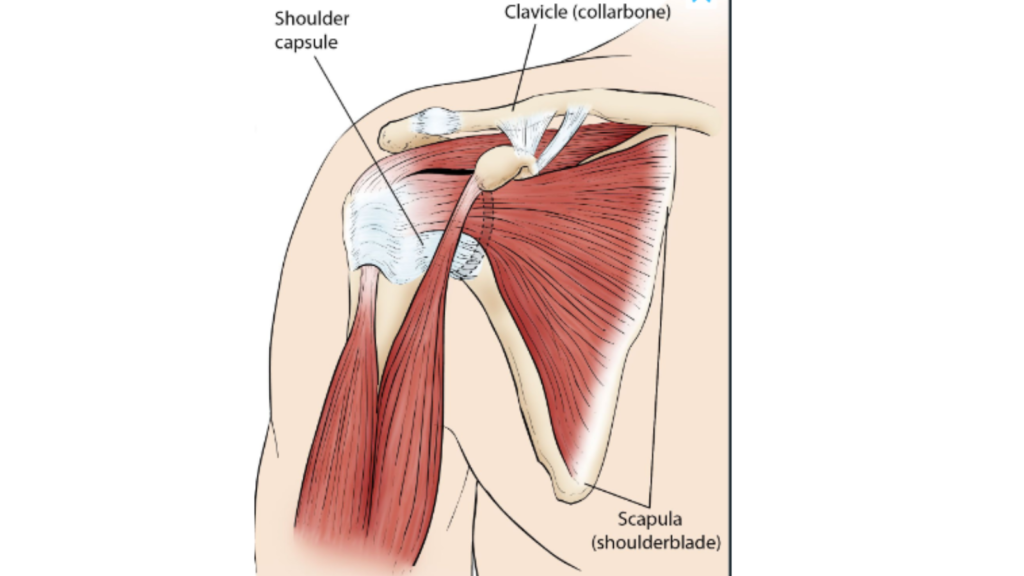
The shoulder joint has a wider and more varied range of motion than any other joint in the body. It’s made up of three bones — the clavicle (collarbone), the scapula (shoulder blade), and the humerus (upper arm bone).
The main joint is a ball-and-socket arrangement called the glenohumeral joint, which joins the top of the upper arm bone to a scooped-out part of the shoulder blade called the glenoid cavity.
The glenohumeral joint lets the shoulder move forward and backward and lets the arm rotate and extend outward from the body. A flexible capsule filled with a lubricant called synovial fluid protects the joint and helps keep it moving smoothly. The capsule is surrounded by ligaments that connect bones to bones, tendons that fasten muscles to bones, and fluid-filled sacs called bursae that cushion tendons and bones during motion.
This elaborate architecture of soft tissues accounts for the shoulder’s marvellous flexibility, but also makes it vulnerable to trauma and chronic wear and tear.
Cause of Frozen Shoulder
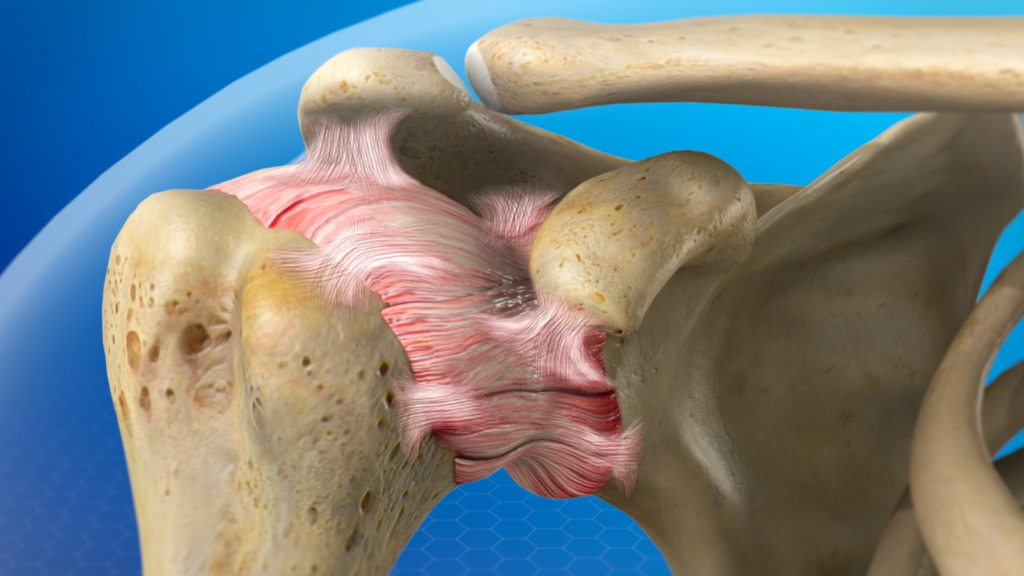
The causes of frozen shoulder are not fully understood after several studies. There is no clear connection to arm dominance (the dominant arm is the arm you prefer to use for most tasks) or occupation. A few factors may put you more at risk for developing frozen shoulder.
- Frozen shoulder occurs much more often in people with diabetes. The reason for this is not known. In addition, diabetic patients with frozen shoulder tend to have a greater degree of stiffness that continues for a longer time before “thawing.”
- Other diseases.Some additional medical problems associated with frozen shoulder include hypothyroidism, hyperthyroidism, Parkinson’s disease, and cardiac disease.
- Immobilization.Frozen shoulder can develop after a shoulder has been immobilized (held in one position without moving) for a period of time due to surgery, a fracture, or other injury. Having patients move their shoulders soon after injury or surgery is one measure prescribed to prevent frozen shoulder.
What are the symptoms of Frozen Shoulder?
A frozen shoulder may take several months to develop. The main symptoms include-
- pain, often worse at night
- stiffness- even raising the arm may be impossible
- Limited range of motion
The hallmark signs of Frozen Shoulder are severe pain and being unable to move your shoulder — either on your own or with the help of someone else. It develops in three stages:
Stage 1: Freezing
In the “freezing” stage, you slowly have more and more pain. As the pain worsens, your shoulder loses range of motion. Freezing typically lasts anywhere from 6 weeks to 9 months.
Stage 2: Frozen
Painful symptoms may actually improve during this stage, but the stiffness remains. During the 4 to 6 months of the “frozen” stage, daily activities may be very difficult.
Stage 3: Thawing
Shoulder motion slowly improves during the “thawing” stage. Complete return to normal or close to normal strength and motion typically takes anywhere from 6 months to 2 years.
Who gets Frozen Shoulder?
People who don’t take part in exercise therapy after an injury or tendinitis are at greatest risk of developing a frozen shoulder. Using a sling without stretching the shoulder can contribute to the condition. A period of enforced immobility as a result of a stroke, heart condition, or surgery may also result in a frozen shoulder. Sometimes the condition occurs without an obvious injury or inflammation. For example, it affects 10%–20% of people with diabetes. Other predisposing conditions include thyroid disorders, depression, and Parkinson’s disease.
People under risk of getting affected by Frozen Shoulder
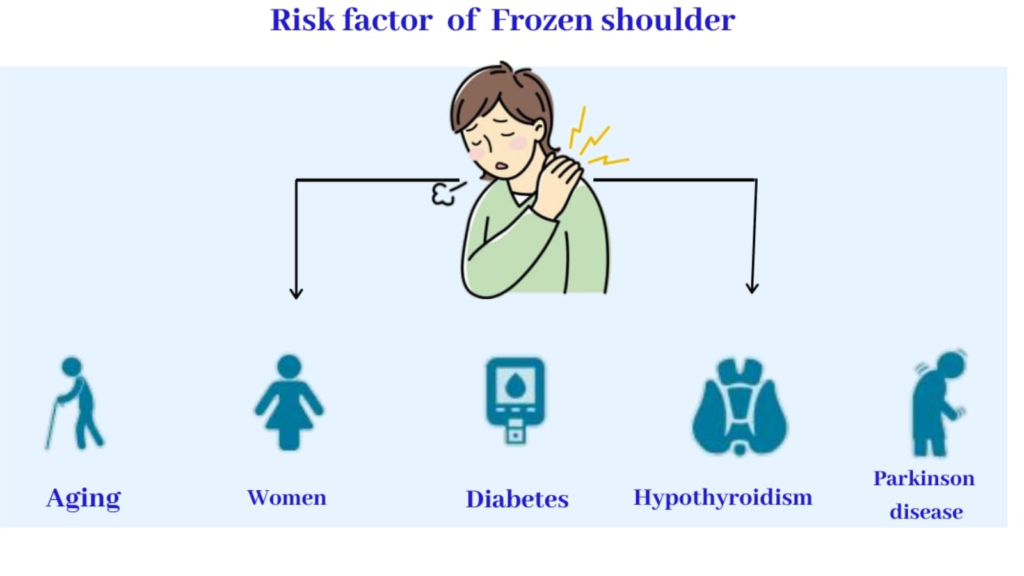
Researches have found some plausible risk factors of frozen shoulder as follows-
- Diabetes mellitus (with a prevalence up to 20%)
- Stroke
- Thyroid disorder
- Shoulder injury
- Dupuytren disease
- Parkinson disease
- Cancer
- Complex regional pain syndrome
How to diagnose Frozen Shoulder?
Physical Examination
After discussing your symptoms and medical history, your doctor will examine your shoulder.
- Your doctor will move your shoulder carefully in all directions to see if movement is limited and if pain occurs with the motion. The range of motion when someone else moves your shoulder is called “passive range of motion.”
- Your doctor will compare this to the range of motion you display when you move your shoulder on your own (“active range of motion”). People with frozen shoulder have limited range of motion both actively and passively.
Imaging Tests
Other tests that may help your doctor rule out other causes of stiffness and pain include:
X-rays. Dense structures, such as bone, show up clearly on X-rays. In addition, X-rays may show other problems in your shoulder, such as Arthritis.
Magnetic resonance imaging (MRI) and ultrasound. These imaging tests can create better images of soft tissues than X-rays. They are not required to diagnose frozen shoulder; however, they may help to identify other soft tissue injuries in your shoulder, such as a Rotator Cuff tear.
What to do if you have Frozen Shoulder?
Frozen shoulder generally gets better over time without surgery, although it may take up to 3 years. The focus of treatment is to control pain and restore motion and strength through physical therapy.
- Consult with doctor– Doctor may advise medicines to manage your unbearable pain and swelling of your shoulder.
- Non-surgical Treatment– Most people with frozen shoulder improve with relatively simple treatments to control pain and restore motion.
- One of the most important things you can do is optimize your other health conditions that might be contributing to the frozen shoulder. For instance, if you are diabetic and your haemoglobin A1C is elevated, developing a plan with your primary care doctor and/or endocrinologist to adjust your diabetes medicine and improve your glucose control can actually help speed up the recovery of your frozen shoulder.
- Applying hot and cold compression packs– Applying heat and cold to your shoulder can ease pain and swelling. Warm compresses increase blood flow to the inflamed area, while cold compresses slow blood flow and reduce swelling and pain. You can alternate between the two. For heal compression, warm a moist towel in the microwave or use a heating pad. Applying to your shoulder for up to 20 minutes, three times a day. For cold compression, wrap an ice pack or bag of frozen vegetables in a towel. Apply it to your shoulder every 2 to 4 hours for no more than 20 minutes at a time. If you’re alternating the two, apply heat for 15 to 20 minutes. A few hours later, apply ice.
- Consult with Physiotherapist– A physiotherapist can teach you stretching and range-of-motion exercises.
- Specific exercises will help restore motion. These may be done under the supervision of a physiotherapist or via a home program. Therapy includes stretching or range of motion exercises for the shoulder. Sometimes heat is used to help loosen the shoulder up before stretching.
Note: Consult with your treating physiotherapist about how many repetitions and sets you should perform of each exercise in each session.
- Home Exercise Program – Your physiotherapist can show you exercises which you can do at home. The patient should engage in home exercises and stretching throughout the healing process. The stretching exercises should be done at home at least once or twice daily. In general, frozen shoulder will resolve almost completely with time and consistent compliance with the prescribed treatment program. This process can take up to six to nine months for some patients, although it may take only a few months for others. Internal rotation (moving the hand to the back pocket or up the middle of your back) is usually the motion that takes the longest to regain.
- Physical exercises– The cornerstone of Frozen Shoulder treatment is physical exercises that stretch the joint capsule. Muscle strengthening comes later.
A physiotherapist can show you how far to push yourself and teach you the appropriate exercises. Once you’ve learned your limitations, you can do most of the stretching routine on your own at home.
While you’re working to stretch the shoulder capsule, try to avoid any sports or daily activities that increase inflammation or aggravate your pain. If you diligently follow your shoulder-stretching regimen, you’ll probably be able to return to your usual level of activity. Full recovery may take several months. If you don’t see steady improvement or you reach a plateau, go back to your Physiotherapist or consult an expert.
Specific exercises will help restore motion. These may be done under the supervision of a physical therapist or via a home program. Therapy includes stretching or range of motion exercises for the shoulder. Sometimes heat is used to help loosen the shoulder up before stretching. Below are examples of some of the exercises that might be recommended.
Note: Consult with your treating physician or physiotherapist about how many repetitions and sets you should perform of each exercise in each session.
Pendulum Exercise-
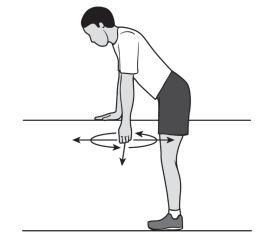
Step-by-step directions
- Lean forward and place one hand on a counter or table for support. Let your other arm hang freely at your side.
- Gently swing your arm forward and back. Repeat the exercise moving your arm side-to-side, and repeat again in a circular motion.
- Repeat the entire sequence with the other arm.
Tips- Do not round your back or lock your knees.
Passive Internal Rotation-
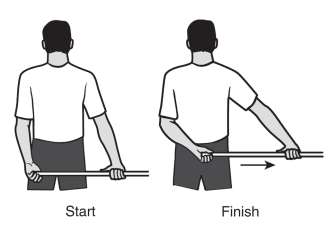
Step-by-step directions
- Hold a stick behind your back with one hand, and lightly grasp the other end of the stick with your other hand.
- Pull the stick horizontally as shown so that your shoulder is passively stretched to the point of feeling a pull without pain.
Sleeper Stretch-
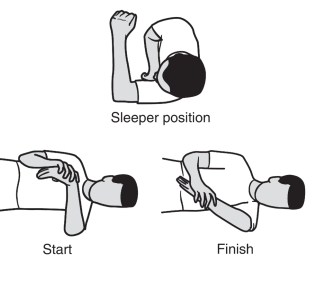
- Hold for 30 seconds and then relax for 30 seconds.
- Repeat on the other side.
Tips– Do not lean over or twist to side while pulling the stick.
External rotation

Passive stretch. Stand in a doorway and bend your affected arm’s elbow to 90° to reach the doorjamb. Keep your hand in place and rotate your body as shown in the illustration. Hold for 30 seconds. Relax and repeat.
Forward flexion-
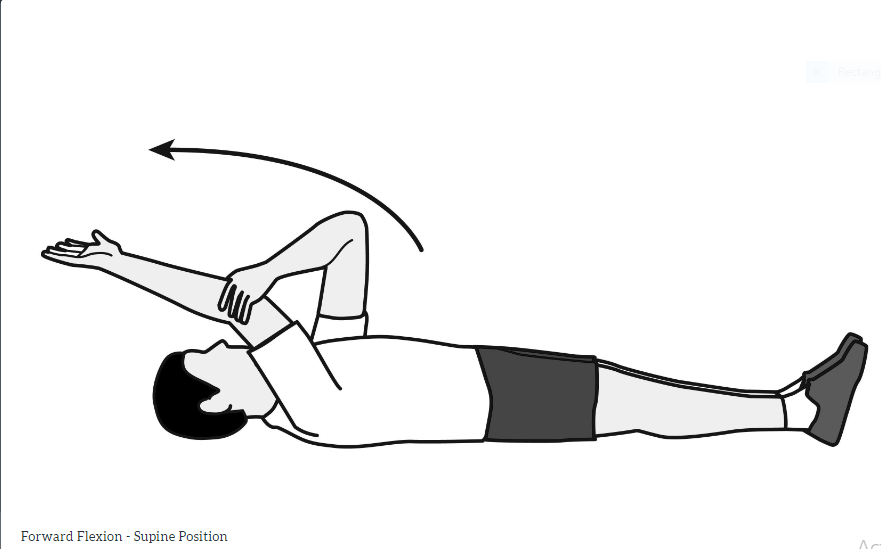
- Supine position.Lie on your back with your legs straight. Use your unaffected arm to lift your affected arm overhead until you feel a gentle stretch. Hold for 15 seconds and slowly lower to start position. Relax and repeat.
Step-by-step directions-
- Lie on your side on a firm, flat surface with the affected shoulder under you and your arm bent, as shown. You can place your head on a pillow for comfort, if needed.
- Use your unaffected arm to push your other arm down. Stop pressing down when you feel a stretch in the back of your affected shoulder.
- Hold this position for 30 seconds, then relax your arm for 30 seconds
Tips– Do not bend your wrist or press down on your wrist
Crossover arm stretch-
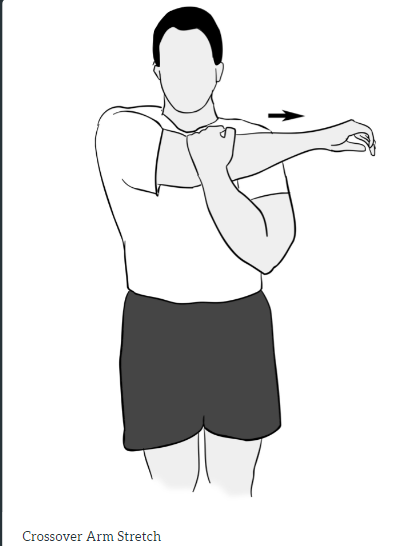
Gently pull one arm across your chest just below your chin as far as possible without causing pain. Hold for 30 seconds. Relax and repeat.
Can diet help if you suffer from Frozen Shoulder?

One of the central causes of frozen shoulder has to do with inflammation. It stands to reason that anything that works in an anti-inflammatory capacity will produce benefits, helping you heal more quickly, or even avoid trouble down the road.
A simple reduction in carbohydrates and saturated trans fats can do wonders, as can an increase in anti-inflammatory foods such as fruits and vegetables, seeds, nuts, oily fish (those with high levels of omega-3 fatty acids), as well as certain spices like ginger and turmeric.
In the same vein, eating healthy foods and avoiding foods that contain processed sugar, you can limit your chances of developing heart disease, or a disorder like diabetes that affects your endocrine system. We know that those with diabetes are much more likely to develop frozen shoulder, so anything you can do that adds a healthy component to your diet will be beneficial.
Foods to avoid with Frozen Shoulder
- Sugar
- Saturated Fat
- Trans Fat
Since elevated levels of sugar in your blood lead to a process known as “glycation,” reducing sugar in your diet can have many positive effects. Glycation reduces elasticity in soft tissues and blood vessels, so with less of it in your food, there is a lower chance of your soft tissues being susceptible to injury, and therefore a lower chance of experiencing the onset of frozen shoulder.
Foods to add more in diet with Frozen Shoulder
Decreasing the amount of inflammation is key, so your diet should focus on adding food that has anti-inflammatory properties. These include:
- Fruits with anti-inflammatory properties (pineapple, berries, red grapes)
- Vegetables with antioxidants, which help rid the body of harmful compounds (such as broccoli, cauliflower, cabbage, sweet potatoes, etc)
- Oily fish (which contains Omega 3 fatty acids)
- Nuts, seeds, avocado, olive oil
- Spices like turmeric and ginger
- Foods rich in probiotics (yogurt, kombucha, kefir, etc)
Does Massage Therapy works for Frozen Shoulder?
Massage is extremely beneficial for managing Frozen Shoulder pain.
Massage helps to relieve tension and tightness so your muscles can relax. This helps to restore mobility and improve function. It also may help improve blood flow to the affected area and reduce inflammation.
While getting a massage often relieves some pain and can temporarily forestall losses in range of motion, it does not cure frozen shoulder.
An experienced massage therapist will be able to successfully treat the symptoms associated with rotator cuff issues and other shoulder injuries, but it is not the kind of treatment that will successfully cure frozen shoulder / adhesive capsulitis.
Conclusion
Experts don’t fully understand what causes frozen shoulder. An inflammatory process is probably involved. Often a shoulder freezes up because it hasn’t been used for a while because of pain, injury, surgery, or illness.
In most cases, a frozen shoulder can be unfrozen, although full recovery may take months and a lot of self-help.
